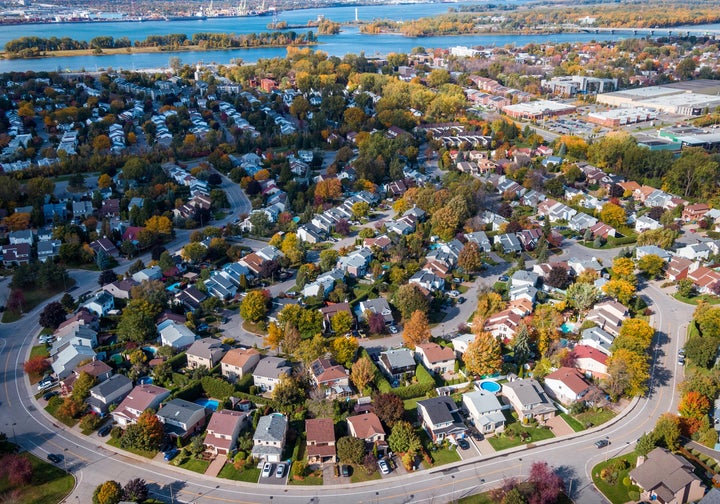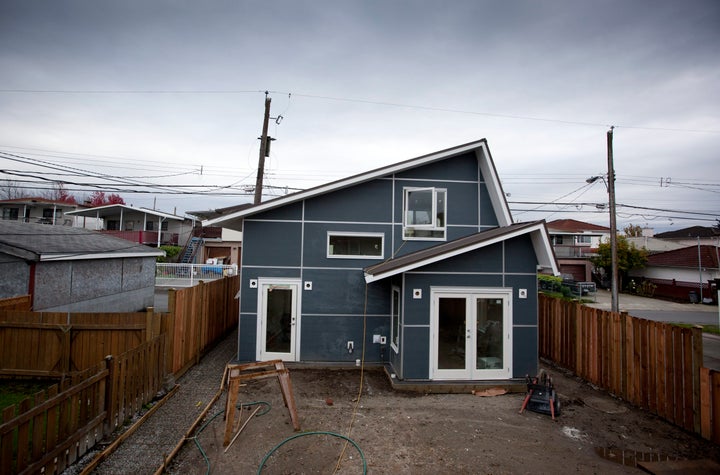
Time to face an ugly reality: Canada is losing the battle to provide affordable housing. Despite a raft of regulations to cool house prices and new programs to build more affordable homes, home prices are now rising faster than incomes once again, and rents are showing no signs of easing.
A recent report from Royal Bank of Canada estimated that Toronto needs to be building twice as many rental units (condos and apartments) to keep up with population growth. All those cranes on the horizon aren’t actually enough.
Unless we want to return to the era of unbridled suburban sprawl, that will mean building more housing in existing urban areas. Sometime soon, when developers run out of post-industrial land next to railyards to build high-rises, we will have to address the fact that the vast majority of residential land in Canada’s metro areas is zoned for single-family homes.
Watch: Some solutions to Canada’s skyrocketing rents. Story continues below.
Many U.S. states on the East and West coasts are facing similar problems, and Oregon, for one, has taken a substantial step: It’s passed a law to end neighbourhoods zoned exclusively for single-family homes. Cities with 25,000 or more people will have to allow duplexes, triplexes, fourplexes and townhomes to be built in all residential areas. California — where the housing shortage has led to an epic homelessness crisis — is now looking at a similar law.
Opponents ― the “not in my backyard” or NIMBY crowd ― say it would mean the end of the suburban lifestyle: The quiet, idyllic nature of suburban neighbourhoods would be replaced by louder, more urban neighbourhoods with heavier traffic.
But supporters of the idea ― the “yes in my backyard” or YIMBY crowd ― say this kind of “gentle densification” would do little to change the character of single-family home areas, while taking serious steps towards more affordable housing and more sustainable cities.
It’s well established that detached-home neighbourhoods use more energy and put a much larger burden on municipal infrastructure, per person, than higher-density neighbourhoods. It’s not a coincidence that Toronto — the only city in the Greater Toronto Area with any real urban density — has the lowest residential property taxes of any city in the region, while the least dense, most outlying communities tend to have the highest.
On the issue of densifying the suburbs, some unlikely coalitions are forming: On one side are developers and urban planners, who argue that Canada’s large cities desperately need the “missing middle” of housing. That’s everything between high-rise condo towers and single-family homes, of which very little is built. And they agree the right place for that development is inside existing neighbourhoods, rather than letting cities continue to encroach onto farmland and nature.
On the other side are the suburban residents who see construction of higher-density homes as an attack on their lifestyle. They moved into these neighbourhoods precisely because they wanted to live in quiet, low-density areas where they don’t have to worry about traffic when the kids are out playing street hockey. No one told them it was for a limited time only.
David-versus-Goliath narrative
The rebellion against densification is building. Voters in the suburban enclave of Burlington, some 60 kilometres west of Toronto, voted in a new mayor after developers started work on a cluster of high-rise condo towers around the city’s historic waterfront, and around Burlington GO Station. The new council, elected in 2018, has frozen development in the downtown area, much to the consternation of developers, until it works out a new development plan.
And thus a David-versus-Goliath narrative is forming, in which the embattled residents of Canada’s suburbs are the noble resistance to the wealthy developers, the politicians in their pockets and the downtown-dwelling, latte-sipping elites who would end the suburban way of life in the name of “sustainability.”
The problem is, this narrative stands in opposition to Canada’s economic, social and environmental policies. As a result of increased immigration levels, Canada’s population is growing at a rate of half a million per year, and more than half of immigrants settle in the country’s three largest metro areas, Toronto, Montreal and Vancouver — nearly 30 per cent in Toronto alone.
From 2019: More than six million people have immigrated into Canada since 1990. Story continues after the video.
Urban planners, politicians and the prevailing trend in public opinion have turned against sprawl. Virtually all the big cities in Canada now have some plan to limit outward growth. And the most recent federal election shows that ensuring affordable housing is now a political priority at the highest levels of government.
There is no miraculous solution here, where somehow Canada’s cities continue to be migrant magnets and economic engines, while at the same time not sprawling outwards or disturbing the character of existing neighbourhoods. There are literally no other options.

But knowing a losing issue when they see one, politicians are kicking the can down the road. The City of Toronto in 2018 allowed for the construction of laneway homes — a small but significant nod towards densifying single-family home areas. But the way the rules were set excludes most residential land in the city’s suburban boroughs. Less than one per cent of Scarborough and less than four per cent of North York qualify for laneway homes. Even in Toronto, densifying the ’burbs is a third rail of politics.
In the coming years and decades, if we see the home ownership rate continue to decline as house prices continue to rise, and as rents eat up an ever larger share of people’s incomes, the pressure will build on politicians to make a decision: Open up the suburbs for densification or go back to sprawl.
Yet our politicians don’t seem ready for the task. Noting that housing shortages in the U.S. are concentrated in economically dynamic, progressive-leaning coastal cities, political writer Matthew Yglesias recently declared that “systematic shortages of housing are liberal America’s greatest policy failing.” That label may soon apply to Canada, too.